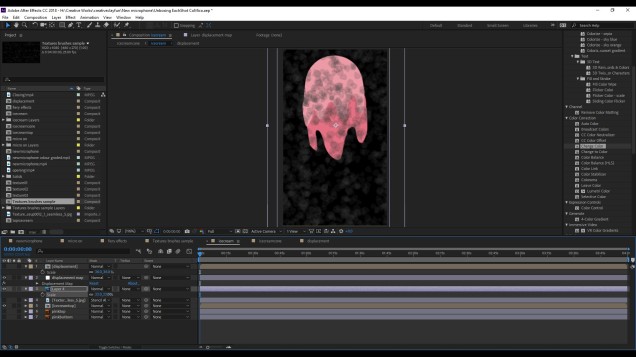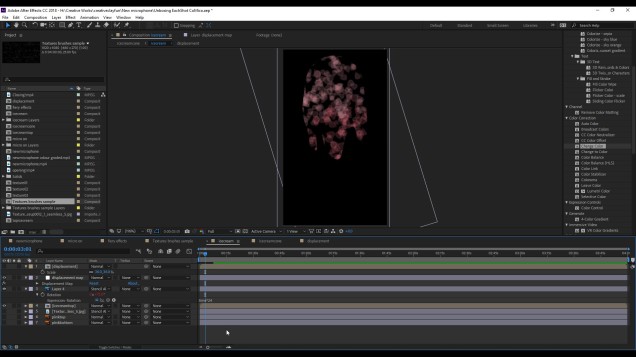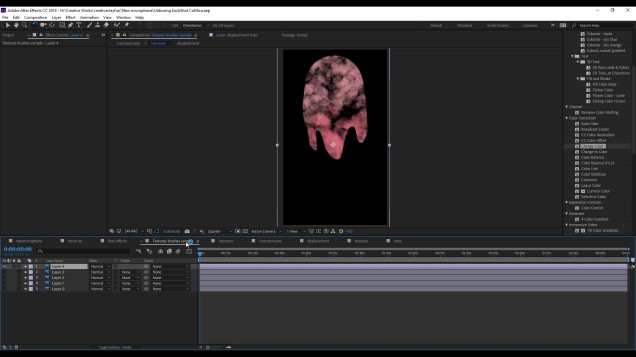Inspired by my recent part time job at a dog day care centre, I decided to do a dog running cycle!
Author: MsLilWallflower
Creating a Fiery Icecream Look on After Effects
Hey guys so I’ve been following Dan Stevers’ work for quite some time. He does great tutorials that have inspired me to play around with the new tools and skills I’ve picked up! The tutorial below was what kick started my own project which I called the Fiery Icecream.
Illustrator
I begin my project with illustrator and create an icecream comprising of three layers. The base is the cone, the mid layer is the first blob of icecream and the top layer is the final blob of icecream.

Handy Tip!
SHIFT+M is the Shape Builder Tool that has been incredibly handy in making a group of objects whole. I learned this through Skillshare by Dylan Mierzwinski who hosts a brilliant class.

After Effects
Next, I place the icecream into After Effects and from Dan Stevers’ tutorial above I have already applied the settings for my icecream. The settings I have planned to only affect the icecream and not the cone. As you can see the leafy textures can be seen by the Stencil Alpha mode.


Now I have made the top of the cone dissolve so that it would not look so awkward as the icecream does it’s fiery melty thing.

I have also adjusted over a time period how there will be an increase in density to make the icecream more apparent.

Here are the resource links I have gathered:
- Dan Stevers Tutorials Playlist:
https://www.youtube.com/playlist?list=PL3D61980A88CCA691 - Dylan Mierzwinski’s tutorial on Illustrator Basics: The Shape Builder Tool
https://www.skillshare.com/classes/Illustrator-Basics-The-Shape-Builder-Tool/418571161/classroom/discussions?via=custom-lists&enrolledRedirect=1
EACHSHOT CoMica Electrit Review on a Nikon D5100
So far… I feel that there isn’t anything much special about the mic. Although I feel that I do need to do more outdoor testing. Will see how it goes over time.
The Breadwinner Review
Earlier in October, I’ve had the exciting privilege to see The Breadwinner at the London BFI festival! The movie was fantastic for sure!
It’s such a shame that I’ve just missed the workshop in Manchester where they’d be breaking down the film in more detail, but anyway this film to me is very inspiring both on an emotional level and on an artistic level.
However I did find a sneak peak whereby the producers Paul Young and Anthony Leo discussed a bit about the film and it’s origins. Apparently The Breadwinner is based on a Canadian book! Then Anthony Leo sought out Cartoon Saloon the Irish animation studio Paul Young is at.
A very interesting point that Charles Solomon (the host and animation historian) made was that there seems to be an increasing use of textures. A certain attraction to the organic such as in films like Kubo and the Two Strings with the stop motion hand made set as well as Trolls that had textures like felt.
The studio Cartoon Saloon had used cintiqs with TV paint software. Young mentions that the studio desired to aim for a more stylistic look, which indeed works well.
Although it’s not possible to gain access to breaking down the making of the film, it is interesting to see segments of their development anyway.
Plot
I thought the story line was so touching and moving. The build up of character development was such a thrilling journey to follow along as Parvana the main character discovers freedom through dressing as a boy. Such a strange perspective yet liberating.
Aesthetic
I really like the animation style for this film. Especially environmental textures that felt rustic and hand made. It definitely motivates me and gives me confidence to create!
Practical Applications
It is also super cool that just like how the book is used for school curriculum (especially in the States and Canada), the film along with its release has plans to be available for educational purposes to help with social understanding.
References:
Updates
So this period of my life is really about job applications… fun… But in the mean time I’ve also been traveling, creating, drawing and making videos! It’s the first time I’ve done any motion graphics before and continue to play and experiment.
I think it would be good for me to return to my blog… and vlog for that matter! My flatmate has been such an encouragement. We are both on a mission to fail! Or more like to put ourselves out there through trial and error. There are some moments of motivation and other moments of lull that makes me want to crawl back into my shell. But that is definitely not the best attitude to approach creativity. Creativity as I am discovering is in fact such a humbling process and I want to aim to share the struggles here and document this journey.
Back After Travels…
… Time to find a job?
Creative Decision Making: Final Overall Review
A great deal of my decision making is associated with my new learning post as most of the work that I have done is a new experience. Thus, through learning from a multitude of sources have been an impacting factor to my creative decision making.
From the beginning, I presented the text that my animation would be based on from the Gospel of Luke chapter 15 verses 11 to 32 from the Bible. Adapting the existing parable would mean requiring creative decision making in the script. How much of what happens is similar, what themes should be the most prominent and dealing with dialogue. I also had researched previous film adaptations of the story, drawing inspiration for narrative and possible aesthetic. Through researching other sources and viewing videos, I made some early tests of aesthetics that included rotoscoping and practice sketches. There were a few factors that led me to working with frame by frame 2D animation is that I had experience in a previous project, that I felt doing something else like rotoscoping would make challenges that are not manageable within the given time, and that I appreciate the aesthetics of films such as Prince of Egypt.
Using live action tests and the animatic helped project the duration. However it was really the constant interrogation from a number of tutors that helped make more concise and clear up any misunderstandings in the animation. Through the work of others online, has helped inspire my working methods and character designs.
Whilst working on character designs, I was also brainstorming for the environmental aesthetics. I knew that I wanted the 2D characters to be within a 3D world to make lighting and texturing more atmospheric. Initially, I constructed the 3D world in Modo902. However, since I did not have Cinema4D, I could not explore the potential it had. Therefore I moved on to creating assets in Photoshop and transferring it to the 3D world of After Effects.
Voice acting was also another aspect that determined some creative decision making. Whilst working with voice actors, we had to get a few different takes to see what matched and what was the most suited to carry the emotions I wanted across. The perspective and length of shots was then adapted to emphasize certain sentences. I found the animation community on online forums helpful in encouragement and critique. It was a place that allowed for consideration and for fresh perspectives to make creative decisions.
In conclusion, creative decision making for me has been majorly influenced in my learning of techniques and inspirations of others. Part of it has also do with test and experiments of my own.
New Learning: Final Overall Review
During the course of the final major project, it has been another challenge level higher than before. I have grown from practicing basic characters and transitions at the beginning of the year, to working with animal movements for the client PROMISE to the end of the year with animating human characters with lip sync. With each transition I have used different methods of working and learned to use alternative software.
For this final project titled ‘Love Returned‘, I began to learn how to use Animate CC, when previously I had been using Photoshop for frame-by-frame animation. This meant that I would have to explore a new aesthetic and what the program can offer. Watching Toniko Pantoja’s tutorials helped my understanding of how to explore Animate CC and what were the possibilities when compositing it in After Effects.
There were many new tasks I needed to experience, such was planning in detail through gantt charts, doing live action tests, working with voice actors, animating people in more detail, perspective and speech. The structure and methodology I set out I have described in my final weekly review. These stages have been malleable and change according to how much I have completed against how much projected time there is left. One method I found to have motivated me to push through with my work is using Rescue Time. By comparing how many hours I put in each day drives me to do better in the following week. Overall I have been able to produce an animation at an acceptable level. The quality meaning the inbetweens, smoothness and body proportions are lacking, however at least not majorly distracting to the viewer.
In terms of the narrative, it has come a long way since the initial script, which was projected to be 10 minutes long. Through a lot of break downs, questioning the relevance of scenes and the guide of tutors, I had been able to shorten the duration to 4 minutes and 30 seconds. The narrative has also developed to be more centered on the older brother Michael, when originally it was clearly focused on the younger brother Ryan.
Looking back over the course of this project, there are a number of aspects and methodologies I would do differently if I had the chance to do this again. Firstly, to be a lot more thorough with the narrative and script writing. I was still making changes in the last quarter of the time given and if I had made the changes earlier, perhaps some aspects to the animation would be much clearer and compelling. Secondly, it would be animating the characters. During the key animating and in-betweening process, that was my practice, exercise and learning period. That is why some shots and scenes look far smoother and consistent than others. These are the aspects that I want to continue developing and to apply these acquired skills for future similar projects.
Promotional Video is out!
Forefront of my current work
So where is my work in relation to the forefront of animation? I would categorize my project Love Returned as a 2D based animation, placed in a 3D world. 2D animation currently is not seen to be at the forefront, instead VR is the next steps in the development. 3D animation and 2D/3D hybrid follow behind. Nowadays, instead of massive transitions in the visual quality of 2D animation, it is the technique, method, software and style that allows for efficiency and diversity.
It is clear that Disney has made the transition from 2D to 3D film production. Many question if there will be a return of 2D from Disney. However, in other parts of the world, 2D still plays a significant role in the animation industry. Makato Shinkai has been made known to be the ‘new’ or ‘second’ Hayao Miyazaki. Within the world he creates, there are elements of 3D and CGI that are seamlessly used. I would regard him and his work at the forefront of 2D animation.
There are other places we can find to be the forefront of 2D animation and those out there testing and sharing their knowledge of its application. Such is Klei Entertainment from a GDC session. Such conferences and talks can help us understand the industry and the directions people are exploring.
Festivals are also good places to keep up and involved in the forefront of animations that associate with the 2D style and technique.
Future direction of 2D hand drawn animation?
In Ireland, director Tomm Moore argues that 2D animation can still evolve and survive, just like how stop-motion has been revived through unique perspectives through studios such as Laika and Aardman. 2D animation is similar to stop-motion in the sense that the techniques have been adapted and mixed with CGI and other media. In this modern age, it is clear that most, if not all animated films are mixed media. However there will always be a main medium that is clear to the viewer of where it is stemmed from.
References
Fenlon, W., 2012. 2D Animation in the Digital Era: Interview with Japanese Director Makoto Shinkai – Tested. [Online]
Available at: http://www.tested.com/art/movies/442545-2d-animation-digital-era-interview-japanese-director-makoto-shinkai/
[Accessed 17 August 2017].
Game Anim, 2017. 2D Animation Klei Entertainment – GAME ANIM. [Online]
Available at: http://www.gameanim.com/2017/06/06/2d-animation-klei-entertainment/
[Accessed 17 August 2017].
Lamble, R., 2016. Studio Ghibli: Marnie, its final films, the future of 2D animation | Den of Geek. [Online]
Available at: http://www.denofgeek.com/movies/studio-ghibli/37209/studio-ghibli-its-final-films-the-future-of-2d-animation
[Accessed 17 August 2017].
Little White Lies, 2016. Makoto Shinkai: ‘You can’t be Miyazaki, you can only be the second Miyazaki’. [Online]
Available at: http://lwlies.com/interviews/makoto-shinkai-your-name/
[Accessed 17 August 2017].
Slurpy Studios, 2009. 2D Animation vs 3D Animation Argument, Debate. [Online]
Available at: http://www.slurpystudios.com/2d-animation-vs-3d-animation/
[Accessed 17 August 2017].
Stein, M., 2016. Will Disney Ever Return to Making Hand-Drawn Animated Films? – The Mickey Mindset. [Online]
Available at: http://www.mickeymindset.com/will-disney-make-hand-drawn-films/
[Accessed 17 August 2017].
August Checked List
Mon 070817 update:
- Drawing building asset 01,02
- Compositing shots 35-48
Tues 080817 update:
- Drawing building asset 03
- Composited (rendered complete) 35,36,37,38
Wed 090817 update:
- FINISHED animation at acceptable and submit-able standard
- Blog post on final weekly review
Thurs 100817 update:
- Editing animation cuts
- Re-drawing opening scene
Fri 110817 update:
- Blog post on forefront: VR Animation
- Promo video
- Re-drawing opening scene
Sat 120817 update:
- Re-drawing opening scene
- Presentation Prep
Sun 130817 update:
- Re-drawing opening scene
- Collecting sound design from Freesound.org
- Discussing with sound designer music arrangements and sound design
VR Animation
VR has been the latest and most exciting technology for the past few decades since the late 50s that has stirred up many forums, discussions and generated ideas. Especially with the multiple possibilities such as games, art and film.

What interests me about the latest development is the story building by Quill from Oculus Rift Story Studio. One of the short VR film narratives is titled Dear Angelica about a daughter recalling memories of her and her mother.
This technology is being trialed by many around the world and shared through the internet. Youtubers such as Draw with Jazza has been able to experiment using one of the first developed animation programmes for VR.
References
Bye, K., 2017. #477: Top 50 VR Storytelling Interviews + Oculus Story Studio Roundtable Discussion | Voices of VR Podcast. [Online]
Available at: http://voicesofvr.com/477-top-50-vr-storytelling-interviews-oculus-story-studio-roundtable-discussion/
[Accessed 11 August 2017].
Draw with Jazza, 2017. My First VR ANIMATION – StickDeath in Virtual Reality! (AnimVR). [Online]
Available at: https://www.youtube.com/watch?v=-o1sV4xlqJQ
[Accessed 11 August 2017].
Freefly VR, 2017. The History of Virtual Reality – Timetravelling. [Online]
Available at: https://freeflyvr.com/time-travel-through-virtual-reality/
[Accessed 11 August 2017].
Freefly VR, 2017. The History of Virtual Reality | Freefly VR. [Online]
Available at: https://freeflyvr.com/history-of-virtual-reality/
[Accessed 11 August 2017].
VRgamer.no, 2017. Dear Angelica | Virtual Reality | Youtube. [Online]
Available at: https://www.youtube.com/watch?v=Wepdt31Fk0M
[Accessed 11 August 2017].